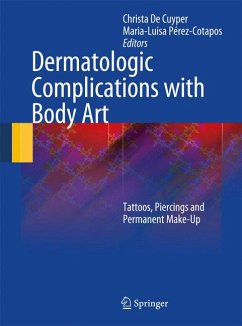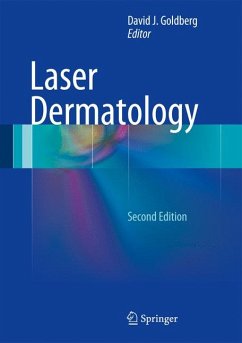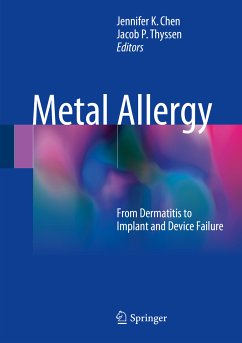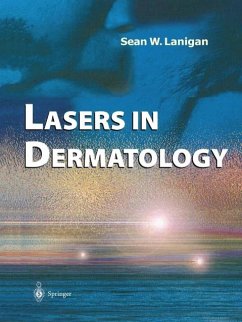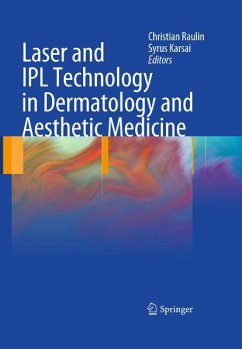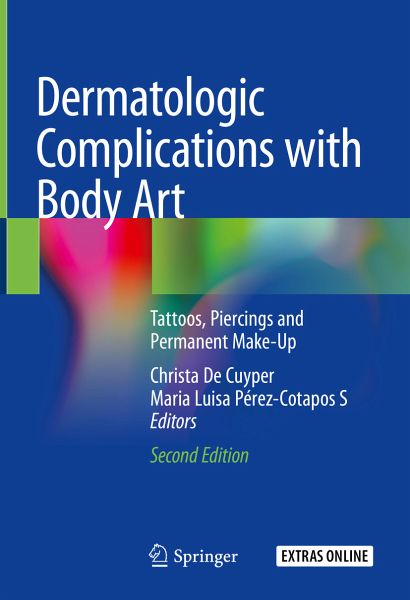
Dermatologic Complications with Body Art (eBook, PDF)
Tattoos, Piercings and Permanent Make-Up
Redaktion: De Cuyper, Christa; Pérez-Cotapos S, Maria Luisa
Versandkostenfrei!
Sofort per Download lieferbar
112,95 €
inkl. MwSt.
Weitere Ausgaben:

PAYBACK Punkte
56 °P sammeln!
Originally published in 2010, this book has since become one of the seminal works in the rapidly evolving field of body piercings, tattoos, and permanent make-up. Authorities, body art professionals, and the general public have become increasingly aware of the risks associated with these practices and the need for better regulation. This second, extensively revised edition includes an update on the literature and focuses more on the epidemiology and classification of adverse reactions. In particular, it addresses recent findings on tattoo inks, their potential side effects and the initiatives ...
Originally published in 2010, this book has since become one of the seminal works in the rapidly evolving field of body piercings, tattoos, and permanent make-up. Authorities, body art professionals, and the general public have become increasingly aware of the risks associated with these practices and the need for better regulation. This second, extensively revised edition includes an update on the literature and focuses more on the epidemiology and classification of adverse reactions. In particular, it addresses recent findings on tattoo inks, their potential side effects and the initiatives being launched by regulating authorities to reduce the risks related to body art.
Dermatologic Complications with Body Art details tattooing procedures in line with the coming European Standards on hygiene (CEN 435 in preparation-release 2018-2019) with extra attention to aftercare. The book features step-by-step video illustrations of different body-art procedures(tattooing, medical tattooing, piercing, and laser tattoo removal). Innovations including medical applications of tattooing are presented. Possible complications, including infections, granulomatous reactions, and allergies are discussed, while new insights on the pathogenesis of allergic reactions are illustrated with the help of recent research data. The book also presents the latest techniques and devices for tattoo removal, together with their risks and benefits. Richly illustrated with videos and pictures, it offers an indispensable guide for dermatologists, physicians and practitioners dealing with body art.
Dermatologic Complications with Body Art details tattooing procedures in line with the coming European Standards on hygiene (CEN 435 in preparation-release 2018-2019) with extra attention to aftercare. The book features step-by-step video illustrations of different body-art procedures(tattooing, medical tattooing, piercing, and laser tattoo removal). Innovations including medical applications of tattooing are presented. Possible complications, including infections, granulomatous reactions, and allergies are discussed, while new insights on the pathogenesis of allergic reactions are illustrated with the help of recent research data. The book also presents the latest techniques and devices for tattoo removal, together with their risks and benefits. Richly illustrated with videos and pictures, it offers an indispensable guide for dermatologists, physicians and practitioners dealing with body art.
Dieser Download kann aus rechtlichen Gründen nur mit Rechnungsadresse in A, B, BG, CY, CZ, D, DK, EW, E, FIN, F, GR, HR, H, IRL, I, LT, L, LR, M, NL, PL, P, R, S, SLO, SK ausgeliefert werden.



